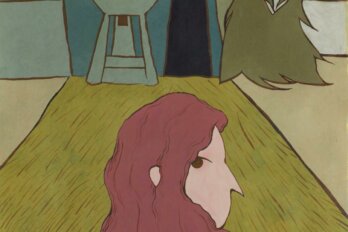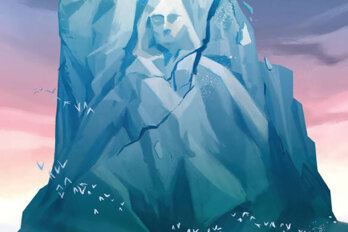It’s not uncommon to see a whole caribou carcass on the kitchen floor at the Niptanatiaks. This time, I help Grace cut the meat into cubes for freezing. We sit on the floor with strips of flesh on flattened cardboard cereal boxes, she with an semicircular ulu knife and I with a sharp conventional blade, working our way through the pile in front of us. Days of Our Lives plays in the background while the kids compete for their uncle Matt’s attention. Soon Matt and Amanda will go check the nets. Grace and Catherine will take a smoke break and Allen will find something to keep himself busy outside. From time to time, Allen looks out at the sky, discerning things that seem wholly mysterious to me. I watch, as usual, and wait.
I’m not sure if it was six or seven young men who died this spring and summer. Someone told me, after the fourth one I think, that you gradually learn to not let it get to you. You have to. That’s what most people seemed to be doing. Sometimes, though, I felt this tight, choking band across my chest and I wanted to walk out the road to the dump and keep on walking. So did Catherine. So did a lot of people.
I spent the summer in Kugluktuk trying to understand how a massacre story from the eighteenth century has been told over the years. What seemed to be an ancient and peripheral story nevertheless led me into peoples’ kitchens to talk about death and loss amid the worst suicide epidemic the town had seen in years. Young men, one after another, were gradually bringing the town to its knees. Death was everywhere, and yet it wasn’t. The Nip girls organized a beach volleyball game for the family on the sand bars behind town. Boats came and went as people headed off to cabins and campsites around Coronation Gulf. Teenagers continued to make midnight rides out to Hart Lake, urging their Hondas along the hard packed sand as they tried to top 100 km/h. There wasn’t a lot of talk about the suicides, even though you could feel it in every conversation, every encounter.
Occasionally, once the kids had gone to sleep, Allen would tell stories. He talked about his trapping days and how he’d put tens of thousands of kilometres on his snow machine each season, circling his trap line over and over and over. Grace told me the story about the first caribou she shot, and laughed about how scared she was, how she thought she’d never shoot it in time. They talked about the last time their daughter’s boyfriend had come camping with them and how hopeful they had been that he was finally getting out on the land. Mostly, though, there was silence, broken by the odd comment about the weather and an invitation to “have coffee, have tea.”
When Allen was young, the Elders told him not to linger in grief. They taught that the dead were in a better place, that death brought relief and a peaceful, happier existence. There was no time for grief, Allen said. Life was for living. And so the people were told not to be sad, but to wish their loved ones well on their next journey. Some of that spirit survives today. And yet among the Elders I spoke with, there seemed also to be a deep sense of bewilderment at what was happening to the young people. “There was no suicide when I was young”, one Elder told me. “We survived, back then. We lived.”
When I told people down south what was happening this summer, they nodded and offered tight, consoling smiles, but the news didn’t actually shock them. People expect grief and tragedy from Canada’s northern Aboriginal communities. They politely prod for stories that might confirm their ideas about alcoholism, poverty, depression, and abuse. In trying to account for the devastating losses people faced in Kugluktuk this summer, I seemed always to be on the verge of recounting the banal. Maybe death is more banal than we want to admit. Or maybe people have grown accustomed to glancing north with glazed eyes. I stopped talking about it.
Once, towards the end of August, I saw a woman bent over with grief, wailing off her back porch. A few teenagers shuffled by and a toddler poked at the dirt with a plastic shovel, happily building trenches between puddles tinged with gasoline. Across the street an old man readied his boat for a trip to Tree River. It’s hard to find words to describe how life goes on in Kugluktuk, even while acknowledging that it doesn’t. I left town a few days later.
Second place entry in the 2007 Student Field Notes Contest



